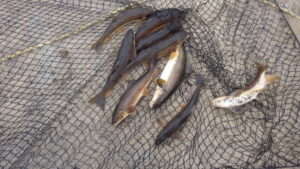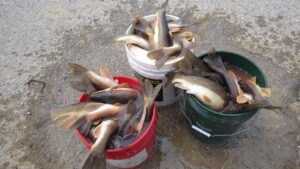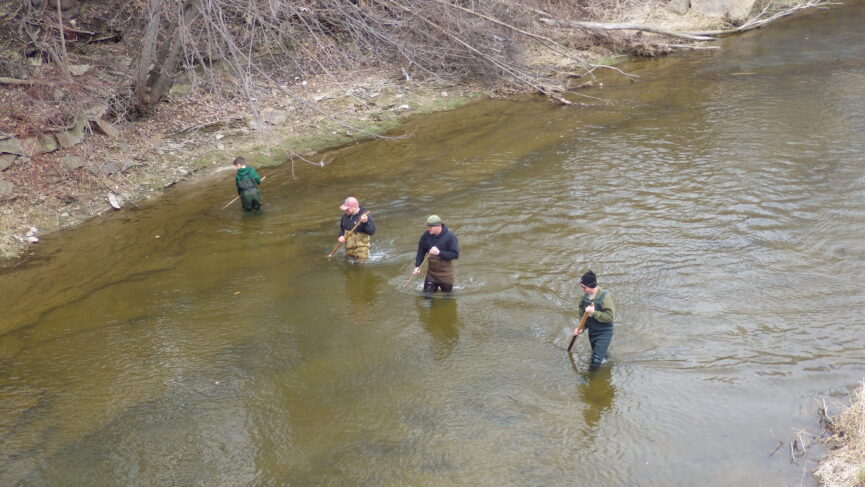
Sucker fishing is right at the top of my springtime agenda, and I have my special haunts for applying the various fishing techniques. The multiple sucker fish species in Michigan get a bit of a bum rap from some folks who consider them to be a trash fish on the order of carp, which is very incorrect. Suckers get their name from their fleshy lipped mouths located on the underside of their heads and are for a fact, bottom feeders. However, they are what I call “clean bottom feeders” in that they feed only on aquatic insects, crustaceans, snails, worms and in some cases, algae too.
Suckers have also been accused of eating the spawn of other game fish species and competing with them in the environment (like carp actually do) which isn’t the case at all. Suckers have nicely coexisted with the various game fish species for eons and are in fact an important prey species for northern pike and muskellunge. Certain sucker species spend most of their time out in the deep water of the Great Lakes and only venture in and up various drainages, rivers and streams to spawn in the spring, which in turn creates a very unique recreational fishery for Michigan sportsfolks. Spring sucker fishing, in its various forms, is a great cure for spring fever, and the flesh from spring-run suckers is absolutely firm and very succulent.
Suckers provide great eating whether they are pan or deep fried, smoked, canned or pickled. When it comes to eating suckers, they are indeed quite a boney fish, and when I have simply fried up the filets, picking out multiple bones while dining is a normal part of the process. However, I will always remember being invited to a fish-fry at the Sebewaing Sportsmen’s Club some years back, and the fish being deep fried up was local suckers. Much to my surprise, I never encountered any bones while enjoying a very distinct and delicate flavor which represents the ritualistic passage of spring.
The key, I discovered, was “scoring” (making slices through the flesh to the skin) sucker filets on a “scoring Board”, which is a wide piece of maple with grooves cut in it at just the right space. Doing so made the bones unnoticeable and I immediately had to have my own scoring board, which I have been using ever since.
I’ve been experiencing “spring sucker spearing” since I was a kid and it still remains to be an annual affair in my neck of the woods. My first sucker spear was actually a pitchfork and it did the trick, after a fashion anyway, and certainly beat nothing at all. However I was glad when I was able to save up and buy a genuine “sucker spear” at the local hardware store. Having barbed tines makes a big difference.
I’ve also always enjoyed spring sucker fishing with a hook and line with my favorite tackle being a 2-hook perch-rig with number 6 or 8 hooks and baited with worms and weighted just enough to take everything to the bottom to reach feeding suckers. There’s not a whole lot of science involved in this method, other than patience, but it is a whole lot of fun, especially when you end up with a pair of suckers on both hooks at the same time!
Another hook and line method I’ve heard about but never tried is using a small treble-hook baited with bits of pink or yellow sponge which is touched up with anise oil. I’ll probably give it a whirl sometime, but have always been plenty satisfied with using dependable, old fashioned worms, because it works.
One spring sucker fishing method that had always intrigued me but I had never tried was using a large dip-net. Then I met my good friend Tom Talaski Sr. of Rapson over 20 years ago, who had been using this fishing method, which involves the whole Talaski family of all ages, since 1975. It is quite a festive affair involving warm camaraderie and plenty of snacks, and I’ve always been quite honored to have been included in their fishing activity at various locations in the “tip of the Thumb”.
Using a dip-net was a distinct learning process for me, because there is quite a knack to it which requires timing and teamwork, and with years of practice to hone matters, the Talaski clan has matters down quite pat. Typically when you think of dip-netting for suckers, you might picture a large (nine feet by nine feet) net being suspended by rope and pulleys from a long pole. The Talaski family, however, do everything by hand. The net is dropped by rope over the edge of a bridge, and then it is swung by one person in a pendulum manner until it is at just the right spot, and then it is dropped to settle down on the bottom. This is when other family members clad in chest-waders and wielding long-handled fish spears, herd the suckers in the direction of the waiting net. The person holding the rope needs to have just the right timing to instinctively know when to give a sudden jerk up toward the surface.
As Tom Talaski Jr. explained to me, when you feel suckers bumping into the net’s metal support rods, it is time to start hauling, because you can’t always see whether or not fish are in the net due to the typical murky water from the spring run-off. Once the net nears the surface, other hands automatically come into play as well to help lift what can sometimes be quite a load of suckers. Generally, if there are no more than eight suckers in the net, it can be lifted all the way up as is. However, if there is a whole load of suckers aboard, a long-handled fishnet is required to remove fish from the much larger net. I’ve been there when this is required, and the Talaski family members roll right through matters as a team with everyone involved knowing what to do. And there is quite a satisfaction to seeing 5-gallon buckets steadily filled up with squirming suckers.

Tom Talaski Sr. had told me that if a warm rain happens, the following morning or so should provide good sucker fishing opportunities, no matter what the weather is on the fishing day. It is very sound advice no matter what sucker fishing method you wish to employ. Tom Talaski Sr. passed away several years ago, but the legacy that is filled with family tradition and involvement he began many years ago is continuing. I truly appreciate the Talaski family giving me an open invitation to join them each spring and I’m always looking forward to it.
Yep, folks, no matter what technique is employed, spring sucker fishing is a great outdoor adventure and the way the weather has been lately, I do believe it will happen sooner than later.
- Fickle weather during December deer hunting adventures - December 3, 2025
- Michigan’s most popular opening day – November 15th - November 23, 2025
- A missing dog found while anticipating opening day - November 23, 2025

